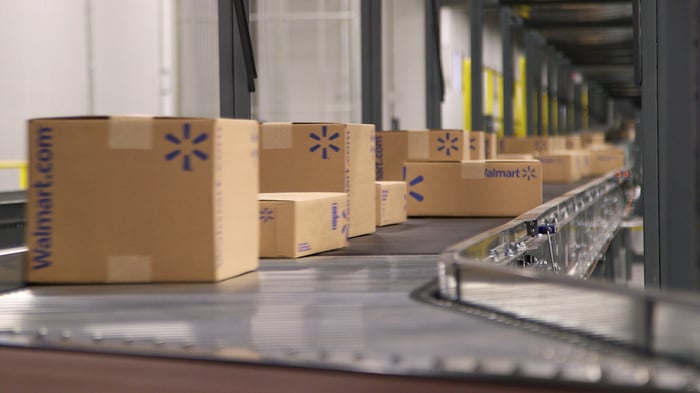Wal-Mart (WMT 0.45%) has gotten aggressive in its battle with Amazon (AMZN -2.31%) for digital sales. The company has massively increased the number of products it sells online while also investing heavily in improving its ability to fulfill web or app orders through its warehouses and stores. In addition, the company has taken the bold step of dropping its $50-a-year Amazon Prime-like ShippingPass program, which gave customers unlimited, free two-day shipping.
Instead, Wal-Mart now offers free two-day shipping on every order of at least $35, in some ways one-upping Amazon's $99-a-year Prime offer, which includes free, two-day shipping among other perks.
These are daring moves led by the company's new head of digital operations Marc Lore, who came to Wal-Mart when it bought his Jet.com start-up for $3.3 billion. The e-commerce boss has preached the idea of Wal-Mart thinking like a start-up. By that Lore means making bold moves (like the free shipping offer) as a way to wrest market share from a well-entrenched competitor.
That strategy can work, but it's very expensive. Start-ups, including Jet.com, and even Amazon as it has grown, lose money as they fight to attain and keep customers. Wal-Mart has decided to take that path, and it's a road fraught with peril.

Wal-Mart now offers free shipping on orders over $35. Image source: Wal-Mart.
Where does Wal-Mart stand now?
"We continue to invest in e-commerce to accelerate growth," said Wal-Mart CEO Doug McMillion during the company's Q4 earnings call, which was transcribed by Seeking Alpha (registration required). "We're gaining traction and moving faster. We're the second-largest U.S. online retailer by revenue, one of the top three online retailers by traffic and our Walmart app is among the top three apps in retail."
"Invest" is the operative word in what McMillion said. Wal-Mart has to spend heavily on infrastructure and it now has to eat the cost of two-day shipping on eligible orders, which drives margins down.
The company has been growing its digital business. In Q4 U.S. e-commerce sales rose by 29% and McMillion said that "Black Friday weekend sales marked the first time the number of people shopping online surpassed people shopping in stores." Those are impressive feats, but it's also worth noting that the company saw its earnings per share (EPS) drop from $1.43 in Q4 2015, to $1.22 in the same period of 2016.
What hurdles does Wal-Mart face?
The company already has scale when it comes to purchasing. That's a big hurdle for most new entrants in the digital space where Amazon has an inherent advantage in the fact that because it buys more, it pays better prices.
Purchase price, however, is only one piece of the digital puzzle. Wal-Mart spent billions buying Jet.com and in some ways that's just the tip of the investment iceberg. Digital technology moves fast and Amazon has never hesitated to put its profits into its next innovation. Whether that's its warehouse network, its fleet of airplanes, or even its wild ideas like drone delivery and mobile trucks 3D-printing orders on demand, progress costs money.
Paying for endless innovation while also having to pay for free shipping drives profits down. In addition, the easy ability for in-store or online customers to price check against Amazon could also force some prices lower.
Not all of Amazon's revenue is from retail sales, but its growth has been incredible. Chart source: YCharts.com.
Can Wal-Mart make money online?
Wal-Mart has the money to be in it for the long haul and since buying Jet.com and putting Lore in charge of its digital business, it seems to have the right people. Growing e-commerce, however, is going to drive profits down, at least for a while. Jet.com, it should be noted, once charged a $50 membership fee and while dropping it did increase sales "the strategy has caused Jet.com to lose money on every shipment, something that would not have been reversed for another five years," The New York Times paraphrased Lore as saying.
Wal-Mart has the scale, some of the infrastructure, and much stronger ability to negotiate prices lower with vendors than Jet.com did on its own. That likely means the company won't lose money on its digital operations long-term or even short-term, but it's going to make less profit on each sale than it traditionally has in its stores.
That's fine if the company can continue to grow its sales volume as it did in Q4. Amazon has essentially built a business where it lives on small margins, but makes it up in volume. Wal-Mart should be able to do the same and it has to because customers are moving toward digital. That said, the world's largest physical retailer is going to spend billions to build a business that's inherently less profitable than the one it's partially replacing.






